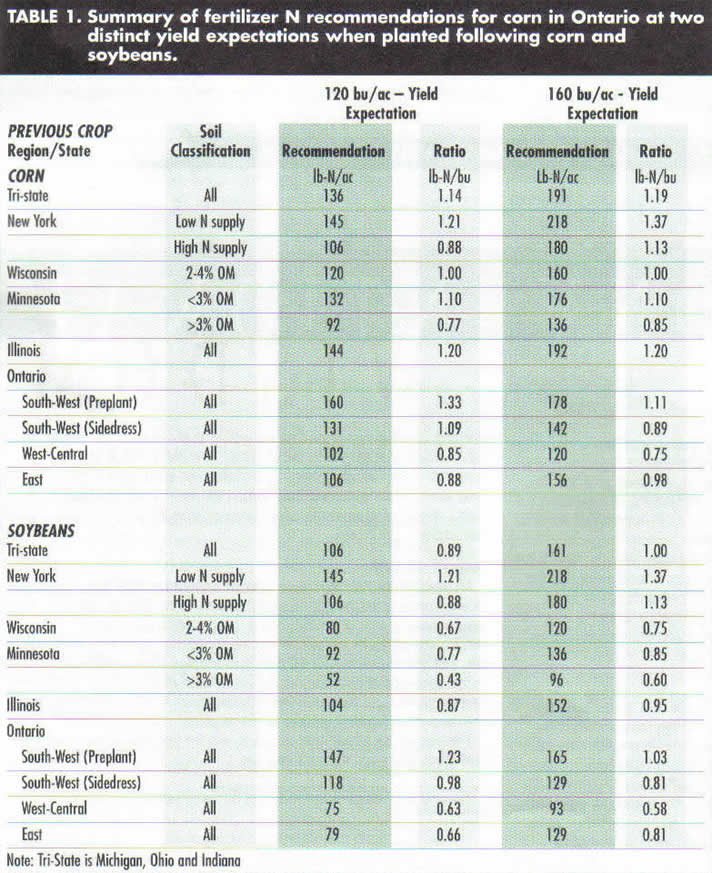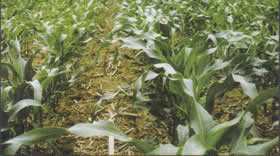
Nitrogen fertilizer
rates for corn are often based on the idea that it takes 1.2 Ib of fertilizer
nitrogen (N) to produce 1 bushel of corn. However, countless research studies
throughout Ontario, and surrounding corn-belt States, suggest that actual fertilizer
N requirements are usually substantially less than the rates predicted using
the 1.2 Ib-N/bu formula. In fact, current nitrogen fertilizer recommendations
for Ontario and surrounding corn-belt States clearly suggest that fertilizer
rates based on the 1.2 Ib-N/bu formula are rarely recommended. What is the historical
basis for the 1.2 Ib-N/bu recommendation? Why is it that nitrogen rates based
on the 1.2 Ib-N/bu formula are rarely appropriate for current day corn production?
Research conducted throughout the 1960's and early 1970's indicated that 1.2
Ib-N/bu was a reasonable predictor of fertilizer N requirements for corn. During
this time, the majority of corn fertilizer N research was conducted where corn
had been planted 
continuously.
Current corn N fertilizer recommendations for surrounding corn-belt states are
presented in Table 1. Current fertilizer N recommendations in surrounding states
where corn follows corn are, for the most part, in the 1.0 to 1.3 Ib-N/bu range.
Exceptions are made in some states where soils have relatively high N supplying
potential and/or high organic matter levels where recommended fertilizer N rates
fall below 1.0 Ib-N/bu even for corn after corn. Current Ontario recommendations
were developed based on the idea that fertilizer N requirements are not consistent
across the province. Only in the south-west region for corn planted following
corn where fertilizer N is applied preplan! does the 1.2 Ib-N/bu formula closely
predict fertilizer N requirements presently recommended in Ontario. Throughout
the rest of the province, and/or when fertilizer N is sidedress applied, current
Ontario fertilizer N recommendations are often less than 1.0 lb-N/bu. Most US
corn-belt States apply a 30 to 40 Ib-N/ac credit for corn planted following
soybeans. This has an effect of almost consistently reducing recommended fertilizer
N rates to less than 1.0 Ib-N/bu for corn following soybeans (Table 1). In fact,
for soils associated with high N supplying capabilities, the fertilizer N recommendations
are often below 0.8 Ib-N/bu. Current Ontario recommendations suggest that soybean
credits are about 13 Ib-N/ac in the southwest and 27 Ib-N/ac throughout the
rest of the province. After applying these soybean credits, current Ontario
N recommendations clearly suggest that fertilizer N rates are less than 1.0
Ib-N/bu. The Ontario Corn Producers' Association, in conjunction with the Agricultural
Adaptation Council (CanAdapt program), provided funding for an examination of
all Ontario corn N research for the purposes of updating/revising current Ontario
recommendations. A preliminary analysis of the historic data suggests that:
1) a 20 to 30 Ib-N/ac credit for corn following soybeans is warranted compared
to growing corn after grain corn
2) that sidedress rates are 10 to 20% lower than the preplan! recommended rate
for the same crop
3) that actual fertilizer N requirements for corn in Ontario are often less
than 1.0 Ib-N per bushel of expected yield when corn follows soybeans in rotation.
 The
1.2 Ib-N/bu formula may have been a reasonable predictor of corn fertilizer
N requirements 30 years ago when there was a tendency to plant corn continuously.
However, now that most corn is planted in rotation, the 1.2 Ib-N/bu formula
often over estimates (by double in many parts of Ontario) corn N fertilizer
requirements. A fact that you may want to consider as you face the challenges
of running a farm operation that is economically viable and environmentally
sustainable.
The
1.2 Ib-N/bu formula may have been a reasonable predictor of corn fertilizer
N requirements 30 years ago when there was a tendency to plant corn continuously.
However, now that most corn is planted in rotation, the 1.2 Ib-N/bu formula
often over estimates (by double in many parts of Ontario) corn N fertilizer
requirements. A fact that you may want to consider as you face the challenges
of running a farm operation that is economically viable and environmentally
sustainable.